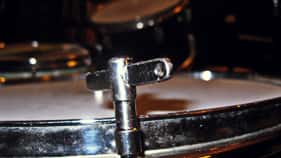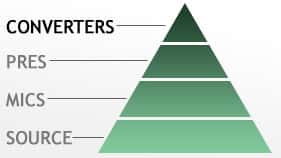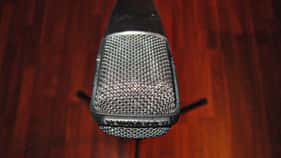
Tom Miking – Catching The Slap, Tone, and Sustain
In the studio, a good sound from a kit’s toms first starts with tuning. See my post on tuning for tips. Once you have a tom that sounds good with the whole kit, the tuning of which fits the song at hand, you can move on to miking the source to capture the three important aspects of a tom’s sound: slap, tone, and sustain.
In the examples I’ve prepared, we are using a 9×13” 1970 Ludwig Standard maple rack tom. It has a coated Evans G1 batter head and a clear Evans G1 resonant head. It is tuned to a medium pitch (with the bottom head looser than the top head in reference to a previous post on tuning drums). All microphones are placed in the same approximate position above the batter head and are recorded through the same Vintech x81 mic pre at approximately the same apparent loudness. No eq or compression has been added so that we hear only the mic.
Shure SM57
 Again, the workhorse 57 makes an appearance. A common choice for toms, the mic seems to emphasize the attack and slap of the toms thanks to its mid boost, though it lacks some of the warmth of the tone that other mics provide. Not a bad choice if you need your toms to cut and “bark.” If the drum you are miking lacks sustain, you may want to try a different mic that emphasizes sustain a little more.
Again, the workhorse 57 makes an appearance. A common choice for toms, the mic seems to emphasize the attack and slap of the toms thanks to its mid boost, though it lacks some of the warmth of the tone that other mics provide. Not a bad choice if you need your toms to cut and “bark.” If the drum you are miking lacks sustain, you may want to try a different mic that emphasizes sustain a little more.
Sennheiser 421
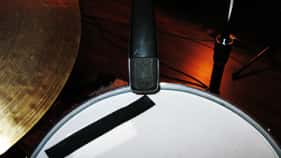 A killer dynamic mic for toms. The low bump warms up the toms’ tone considerably while the super high end bump flatters the slap of the tom. This mic makes toms sound warm and big, while retaining the initial transient. In comparison, the 57 “barks” a little more, but the 421 captures more warmth and sustain.
A killer dynamic mic for toms. The low bump warms up the toms’ tone considerably while the super high end bump flatters the slap of the tom. This mic makes toms sound warm and big, while retaining the initial transient. In comparison, the 57 “barks” a little more, but the 421 captures more warmth and sustain.
Blue e100
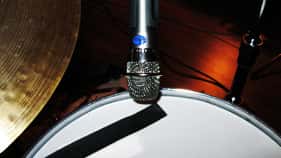 A cool dynamic mic from Blue, the e100 is kind of like the missing link between the 57 and the 421. It retains attack like the 57, but it offers more warmth than the 57. It does end up representing the toms as a little dark. You may want to add some hi end EQ to combat the darkness of the mic.
A cool dynamic mic from Blue, the e100 is kind of like the missing link between the 57 and the 421. It retains attack like the 57, but it offers more warmth than the 57. It does end up representing the toms as a little dark. You may want to add some hi end EQ to combat the darkness of the mic.
Blue Mouse
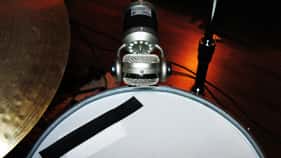 Ah, the mouse. I really like this mic on toms. You have to make sure the drummer won’t hit these, because large diaphragm condensers are much more susceptible to damage from errant sticks. The mouse trades off a bit of slap and focused attack for a more broad and even tone that really emphasizes sustain of the tom. Like the e100, you’ll want to add back some high end EQ. To me, the tom sounds refreshingly open. The mouse does require a pre with a pad or a pre capable of low input gain as the mic output is hot.
Ah, the mouse. I really like this mic on toms. You have to make sure the drummer won’t hit these, because large diaphragm condensers are much more susceptible to damage from errant sticks. The mouse trades off a bit of slap and focused attack for a more broad and even tone that really emphasizes sustain of the tom. Like the e100, you’ll want to add back some high end EQ. To me, the tom sounds refreshingly open. The mouse does require a pre with a pad or a pre capable of low input gain as the mic output is hot.
I used mics at my immediate disposal to write this post. I suppose I could have hunted down other mics such as AKG 414s, Audix D4s, Sennheiser e604s, etc., but the point I am trying to illustrate can be made with the four samples provided. Just changing a mic on the source can yield a fairly dramatic difference in the sound going to tape/disk. The more mics you sample, the more you will be able to make creative decisions in the moment on sessions to sculpt the sound of the drums before you even reach for EQ or compression.

